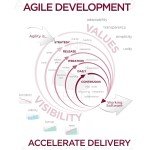My Product Management Manifesto
We live in California. Silicon Valley is in California. We must think big, because people with great aspirations came here from all over the world. They can make software even better than us. Here are some things we can do to stay ahead of the game
Go for breakthrough, high risk, highest possible reward products
The product portfolio definitions are:
- Breakthrough products. High risk extremely hard rewards. Think Google, Android, Windows
- Platform products. Medium risk medium reward. Think me-too office apps
- Derivative products. Low risk and low reward. New version releases of the same product
Do NOT do this:
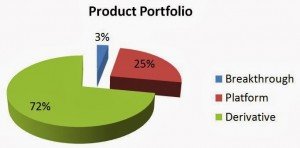
This is what we shall do:
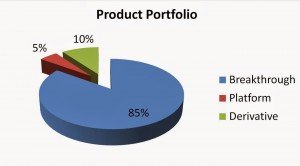
Or even better:
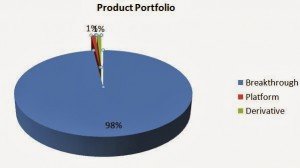
The charts above summarize what I learned in UC Berkeley seven years ago. Berkeley is always at least ten years ahead of other people time. We have to liberate ourselves from the chains of numerical Return on Investment (ROI) and forecasts. Financial numerical decision makers do not work in Breakthroughs, Companies should change the culture and invest more in breakthroughs than in the past. Their reliance on what you see in Fig. 1 will not lead to real competitiveness, real differentiation, particularly when engineers are available not only in US but in Lithuania, Czech Republic, and the entire Asia, just to pick some countries from hundreds who learned how to code impeccably
You may ask how the hell to get approval without financial goals approved in large companies. My feeling is this: guys you do your beans accounting and get ideas, but do NOT become the slaves of those things. Make abstraction of their existence, think, and then later, when you know better do again for orientations some financial analysis.
Come to live in Silicon Valley at least for one year
If your company is from Skopje Illinois, or South Dakota, Romania etc., bring your executives and families to live in Silicon Valley vicinity for one year at least.
How to price your product
The wrong way
- DO NOT do pricing as cost plus margin
- DO NOT rush to drop the prices when you see no sales.
- DO NOT lower prices and give away profits to gain an illusory market share
The Market Share pricing is flawed for most people, unless you are monopoly. Who ever is a monopoly is too arrogant to read this blog
The right way to do pricing
Use this formula to build prices
EVC = Reference Value + Differentiation Value
EVC is the Economic Value to the Customer. This is the maximum amount a customer is willing to pay, assuming s/he is fully informed about the benefits of the product.The Differentiation Value, could be + or – is difference between your product and the closest substitute.
There is no product management if one ignores competition and alternative. Note that various customers in various market segments or geographical locations or industries have DIFFERENT perceptions of EVC.
Therefore we can not have one price for everyone. When we did Sun Grid Engine product, we sold the same product from zero (Open Source in education) to $600,000 to top defense organizations
Educate the customer to see the Economic Value specific to her. Know their business, and learn how much money they will save. This is much more productive than dropping prices unnecessarily.
Some people call this “opportunity pricing”. Yes, our challenges are nothing but opportunities. Ask;
Do you know how much money you loose each week you are not buying our product / technology / solution?
Strategy
- Whatever strategy where competition is ignored, is no longer a strategy. Competition is everywhere
- Product Managers live in a world of uncertainty. If we don’t understand it, yet we extract constant opportunities
Benefits we seek to capture
- One dimensional – increase the performance in these attributes to get a linear increase in satisfaction
- Must-Be – if we don’t have them, customers are not satisfied. Increasing the level of the attribute does not get more satisfaction
- Attractive – When the attribute is lacking, customer is not dissatisfied; but when the attribute is present, the customer is often extremely satisfied and often “delighted” (typically the delight is not articulated by the customer and must be discovered)
Once you discover the benefits, deliver the minimum features that will make the customer delighted, mesmerized. Usually this is called Customer Experience and refers to the user feelings.
What are user feelings? Just try to sell a Windows laptop to an Apple adoring fan.
Travel, Travel, Travel
One can have the best engineering product in the world, but the lousiest revenues without a good product management. A Product Manager NEEDS to visit eye to eye customers. The intelligence, the body language, the focused conversation, the coffee, the small talk complements the information. People will never use products they do not like or have a preconceived grudge against them. As Karen Leland writes
I’m a huge fan of social media. I teach it; I write about it; I develop small business strategies around it. But I believe that even in today’s wired world in-person meetings meetings are a key ingredient in establishing relationships and an essential part of being productive.
Online, one can have simply the information sharing quadrant. Meeting Face-to-Face, we land into the motivation and inspiration quadrant
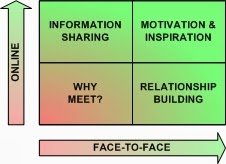
And don’t forget: every successful CEO is a de-facto an extremely successful product manager. I am saying this consistently since 2006


